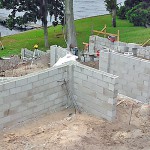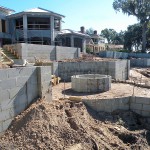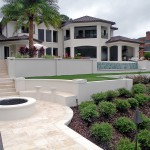No matter the size or style of the block or if it is going to be covered or not, EK Birken Masonry contractors ensure that they install the cleanest quality craftsmanship the customer deserves.
Concrete block has been used as a building material for more than a century. In some regions, concrete block is also a common building material frequently used in home construction. Generally, concrete blocks are fabricated using products such as portland cement, different aggregates such as stone or quartz, and water. The chances are also high that you’ve seen many concrete block homes that don’t look like they’re made out of concrete block because of their external facings or coverings.
Concrete Block Construction Characteristics
A concrete block is referred to as a concrete masonry unit, or CMU, in the construction industry. Concrete blocks can be solid or hollow, with two or three cores or voids. The blocks also come in a range of standard shapes. Generally, concrete blocks measure 16 inches long by 8 inches wide by 8 inches high, though their actual widths and heights are a 3/8 inch less. Concrete blocks are lightweight, durable, and fireproof, making them a useful homebuilding material.
Concrete Block Construction Pros
When they’re assembled and built correctly, concrete blocks are ideal for foundations and basement walls because they’re stronger than poured concrete. Partition walls in any home can be put up quickly using concrete blocks, and their cores or voids can be filled with steel-reinforcing rods and concrete for additional strength. Concrete block is unaffected by termites or extreme temperatures and is virtually soundproof, depending on construction quality. Concrete blocks also provide insulation against cold and heat and may reduce a home’s energy usage.
PRECAST CONCRETE MASONRY AND CONSTRUCTION OF WALLS
Precast Concrete Masonry Blocks:
These blocks are manufactured by vibrating a stiff concrete mixture into metal molds, immediately turning them out wet onto a rack (so that the mold can be reused immediately) at a rate of 1000 or more units per hour. Racks are cured at an accelerated rate by subjecting them to steam, either at the atmospheric pressure or at higher pressure for faster curing. After the units are steam cured, they are dried to a specific moisture content and bundled in wooden crates for shipping to the construction site.
Masonry grades:
Type N: For general use above or below grade; S grade: Above-grade use only.
- Type I – Moisture-controlled units for use where drying shrinkage of units would cause cracking in concrete masonry
- Type II – Non-moisture-controlled units. Weights: normal, medium and light
Laying of Concrete Blocks in Walls:
- Mortar used in stone masonry is identical to the one used earlier in brick masonry construction
- Only the face shells of the block are mortared with the webs unsupported
- Often reinforced with steel to increase its load-bearing capacity and its resistance to cracking
- Often reinforced with horizontal reinforcement steel, introduced as welded grids of small-diameter steel rods, that are laid onto the bed joints at the desired vertical intervals
Concrete Block Construction Cons
Poured concrete can simply be filled into a foundation hole and allowed to harden, while concrete block must be built correctly to avoid future foundation buckling. Unless facing such as stucco is applied over it, concrete block has a basic industrial look that might not be appealing. Incorrectly built concrete block foundations and basements may sustain water damage on land with a high water table. Concrete block is also more expensive as a building material than wood.
Deciding on Concrete Block Construction
Concrete block homes are sturdy once inexpensive steel-reinforcing rods and wet concrete are placed in the cores. Thus, these homes can remain in good condition for years. However, homes built of wood are less costly to construct, not only because wood is lightweight and plentiful, but also because builders can build such homes quickly.
Don’t see what you’re looking for, or have a question or issue that’s not covered above? See examples of EKB Masonry’s previous work by visiting our gallery, or contact us to discuss your next project.



